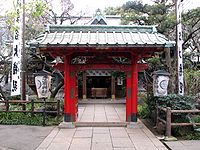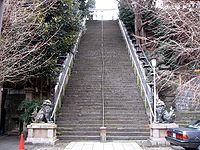
Atago Shrine (Tokyo)
Encyclopedia


Minato, Tokyo
is one of the 23 special wards of Tokyo, Japan. As of 1 March 2008, it had an official population of 217,335 and a population density of 10,865 persons per km². The total area is 20.34 km².Minato hosts 49 embassies...
, Tokyo
Tokyo
, ; officially , is one of the 47 prefectures of Japan. Tokyo is the capital of Japan, the center of the Greater Tokyo Area, and the largest metropolitan area of Japan. It is the seat of the Japanese government and the Imperial Palace, and the home of the Japanese Imperial Family...
, Japan
Japan
Japan is an island nation in East Asia. Located in the Pacific Ocean, it lies to the east of the Sea of Japan, China, North Korea, South Korea and Russia, stretching from the Sea of Okhotsk in the north to the East China Sea and Taiwan in the south...
is a Shinto
Shinto
or Shintoism, also kami-no-michi, is the indigenous spirituality of Japan and the Japanese people. It is a set of practices, to be carried out diligently, to establish a connection between present day Japan and its ancient past. Shinto practices were first recorded and codified in the written...
shrine built in 1603 (the eighth year of the Keichō
Keicho
was a after Bunroku and before Genna. This period spanned from October 1596 to July 1615. The reigning emperors were and .-Change of era:* 1596 : The era name was changed to Keichō to mark the passing of various natural disasters...
era) on the order of Shogun
Shogun
A was one of the hereditary military dictators of Japan from 1192 to 1867. In this period, the shoguns, or their shikken regents , were the de facto rulers of Japan though they were nominally appointed by the emperor...
Tokugawa Ieyasu
Tokugawa Ieyasu
was the founder and first shogun of the Tokugawa shogunate of Japan , which ruled from the Battle of Sekigahara in 1600 until the Meiji Restoration in 1868. Ieyasu seized power in 1600, received appointment as shogun in 1603, abdicated from office in 1605, but...
. The current shrine was rebuilt in 1958.
The shrine is located on Atago Hill, which is 26 meters above sea level
Sea level
Mean sea level is a measure of the average height of the ocean's surface ; used as a standard in reckoning land elevation...
. In old times, the shrine had an excellent view of Tokyo, now obscured by high rises. The very steep stairs leading to the shrine are also famous, as they represent success in life.
According to legend, a young samurai
Samurai
is the term for the military nobility of pre-industrial Japan. According to translator William Scott Wilson: "In Chinese, the character 侍 was originally a verb meaning to wait upon or accompany a person in the upper ranks of society, and this is also true of the original term in Japanese, saburau...
dared to ride his horse up the stairs to deliver plum blossoms to the shogun
Shogun
A was one of the hereditary military dictators of Japan from 1192 to 1867. In this period, the shoguns, or their shikken regents , were the de facto rulers of Japan though they were nominally appointed by the emperor...
. It took his horse only one minute to get up, but 45 minutes to get down, and the horse was totally exhausted afterwards.
The shrine was erected to protect the residents from fire, since its formerly excellent view was well suited to watch for fires, and therefore the main Shinto god
Kami
is the Japanese word for the spirits, natural forces, or essence in the Shinto faith. Although the word is sometimes translated as "god" or "deity", some Shinto scholars argue that such a translation can cause a misunderstanding of the term...
worshiped in this shrine is the fire god Homusubi no Mikoto. Other gods worshipped are also Mizuhanome no Mikoto (a god of water), Ōyamazumi no Mikoto (a god of mountains) and Yamato Takeru no Mikoto (a god of military).
External links
- Official website (in Japanese)

